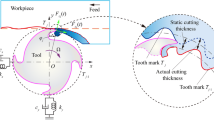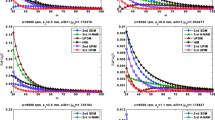Abstract
The introduction of chatter limits the processing efficiency of milling. Chatter prediction is an off-line strategy to select chatter-free cutting parameters. This paper presents a novel method for prediction of milling chatter which aims to reduce the dimension of transition matrix of the discrete map, where the eigenvalues of the transition matrix determine the system stability by using Floquet theory. A linear weight function is introduced when the weighted residual method is applied to the delay differential equation on discrete time intervals. Thus the displacement item can be removed from the state vectors. When the number of discrete intervals is fixed, it is concluded that the transition matrix obtained by the proposed method is the smallest among the time-domain methods. Meanwhile, the acceleration continuity condition is naturally satisfied on discrete time nodes which endows the method with competitive accuracy.
Similar content being viewed by others
References
Altintas, Y.: Manufacturing Automation: Metal Cutting Mechanics, Machine Tool Vibraion, and CNC Design. Cambridge University Press, Cambridge (2000)
Altintas, Y., Budak, E.: Analytical prediction of stability lobes in milling. Cirp Ann. Manuf. Technol. 44(1), 357–362 (1995)
Altintas, Y., Stepan, G., Merdol, D., Dombovari, Z.: Chatter stability of milling in frequency and discrete time domain. CIRP J. Manuf. Sci. Technol. 1(1), 35–44 (2008)
Asl, F.M., Ulsoy, A.G.: Analysis of a system of linear delay differential equations. J. Dyn. Syst. Meas. Control 125(2), 215 (2003)
Bayly, P.V., Halley, J.E., Mann, B.P., Davies, M.A.: Stability of interrupted cutting by temporal finite element analysis. J. Manuf. Sci. Eng. 125(2), 220–225 (2003)
Butcher, E.A., Bobrenkov, O.A.: On the Chebyshev spectral continuous time approximation for constant and periodic delay differential equations. Commun. Nonlinear Sci. Numer. Simul. 16(3), 1541–1554 (2011)
Butcher, E.A., Bobrenkov, O.A., Bueler, E., Nindujarla, P.: Analysis of milling stability by the chebyshev collocation method: algorithm and optimal stable immersion levels. J. Comput. Nonlinear Dyn. 4(3), 031003 (2009)
Ding, Y., Zhu, L., Zhang, X., Ding, H.: A full-discretization method for prediction of milling stability. Int. J. Mach. Tools Manuf 50(5), 502–509 (2010)
Ding, Y., Zhu, L., Zhang, X., Ding, H.: Numerical integration method for prediction of milling stability. J. Manuf. Sci. Eng. 133(3), 031005 (2011)
Ding, Y., Zhu, L., Zhang, X., Ding, H.: Stability analysis of milling via the differential quadrature method. J. Manuf. Sci. Eng. 135(4), 044502 (2013)
Eksioglu, C., Kilic, Z., Altintas, Y.: Discrete-time prediction of chatter stability, cutting forces, and surface location errors in flexible milling systems. J. Manuf. Sci. Eng. 134(6), 061006 (2012)
Henninger, C., Eberhard, P.: Improving the computational efficiency and accuracy of the semi-discretization method for periodic delay-differential equations. Eur. J. Mech. A Solids 27(6), 975–985 (2008)
Huang, T., Zhang, X., Zhang, X., Ding, H.: An efficient linear approximation of acceleration method for milling stability prediction. Int. J. Mach. Tools Manuf. 74(8), 56–64 (2013)
Insperger, T.: Semi-discretization method for delayed systems. Int. J. Numer. Methods Eng. 55(5), 503–518 (2002)
Insperger, T., Stepan, G.: Updated semi-discretization method for periodic delay-differential equations with discrete delay. Int. J. Numer. Methods Eng. 61(1), 117–141 (2004)
Khasawneh, F.A., Mann, B.P., Butcher, E.A.: A multi-interval Chebyshev collocation approach for the stability of periodic delay systems with discontinuities. Commun. Nonlinear Sci. Numer. Simul. 16(11), 4408–4421 (2011)
Kostić, S., Franović, I., Todorović, K., Vasović, N.: Friction memory effect in complex dynamics of earthquake model. Nonlinear Dyn. 73(3), 1933–1943 (2013)
Li, M., Zhang, G., Huang, Y.: Complete discretization scheme for milling stability prediction. Nonlinear Dyn. 71(1–2), 187–199 (2013)
Merritt, H.: Theory of self-excited machine tool chatter. J. Eng. Ind. 87, 447–454 (1965)
Niu, J., Ding, Y., Zhu, L., Ding, H.: Runge–kutta methods for a semi-analytical prediction of milling stability. Nonlinear Dyn. 76(1), 289–304 (2014)
Olgac, N., Sipahi, R.: A unique methodology for chatter stability mapping in simultaneous machining. J. Manuf. Sci. Eng. 127(4), 791–800 (2005)
Olgac, N., Sipahi, R.: Dynamics and stability of variable-pitch milling. J. Vib. Control 13(7), 1031–1043 (2007)
Ozoegwu, C.G., Omenyi, S.N., Ofochebe, S.M.: Hyper-third order full-discretization methods in milling stability prediction. Int. J. Mach. Tools Manuf. 92, 1–9 (2015)
Smith, S., Tlusty, J.: Efficient simulation programs for chatter in milling. Ann. CIRP 42, 463–466 (1993)
Tlusty, J., Polacek, M.: The stability of the machine tool against self-excited vibration in machining. ASME Int. Res. Prod. 1, 465–474 (1963)
Tobias, S.A.: Machine-Tool Vibration. Wiley, Hoboken (1965)
Vasović, N., Kostić, S., Franović, I., Todorović, K.: Earthquake nucleation in a stochastic fault model of globally coupled units with interaction delays. Commun. Nonlinear Sci. Numer. Simul. 38, 117–129 (2016)
Yi, S., Nelson, P., Ulsoy, A.: Delay differential equations via the matrix lambert W function and bifurcation analysis: application to machine tool chatter. Math. Biosci. Eng. 4(2), 355 (2007)
Author information
Authors and Affiliations
Corresponding author
Appendix
Appendix
1.1 A. Matrices in Eq. (17)
1.2 B. Program Code



Rights and permissions
About this article
Cite this article
Huang, T., Zhang, X. & Ding, H. A novel approach with smallest transition matrix for milling stability prediction. Nonlinear Dyn 90, 95–104 (2017). https://doi.org/10.1007/s11071-017-3649-0
Received:
Accepted:
Published:
Issue Date:
DOI: https://doi.org/10.1007/s11071-017-3649-0




